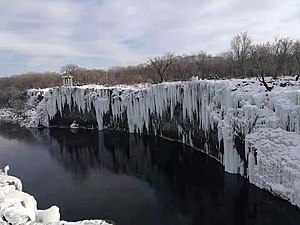Jingpo Lake
| Lake Jingpo | |
|---|---|
 | |
 Lake Jingpo | |
| Location | Ningan County, Heilongjiang |
| Coordinates | 43°52′48″N 128°56′24″E / 43.88000°N 128.94000°ECoordinates: 43°52′48″N 128°56′24″E / 43.88000°N 128.94000°E |
| Basin countries | China |
| Max. length | 45 km (28 mi) |
| Max. width | 6 km (3.7 mi) |
| Surface area | 95 km2 (37 sq mi) |
| Max. depth | 62 m (203 ft) |
| Jingpo Lake | |||||||||||
|---|---|---|---|---|---|---|---|---|---|---|---|
| Traditional Chinese | 鏡泊湖 | ||||||||||
| Simplified Chinese | 镜泊湖 | ||||||||||
| Literal meaning | "Mirror Lake" | ||||||||||
| |||||||||||
Jingpo Lake or Lake Jingpo[1] (Chinese: 镜泊湖; Pinyin: Jìng Pō Hú) is a lake located in the upper reaches of the Mudan River among the Wanda Mountains in Ningan County, Heilongjiang Province, in the People's Republic of China. Earlier names for the lake include Meituohu Lake (湄沱湖), Huhanhai Lake (忽汗海), and Bilten Lake (Manchurian: ᠪᡳᠯᡨᡝᠨ; Chinese: 畢爾騰湖).
The length of the lake from north to south is 45 kilometers (28 mi) and the widest distance between east and west is only 6 kilometers (3.7 mi). The area is 95 km2 (37 sq mi) and the storage capacity is 1.63 billion m3. The south part of lake is shallow with the deepest place in the northern part at 62 meters (203 ft).
The winter average temperature in Heilongjiang Province is below -20°C (-4°F), but the temperature at the bottom of the water is always above 10°C (50°F).[2]
On Titan, the largest moon of the planet Saturn, there is a large surface body of liquid hydrocarbons, Jingpo Lacus, named after Jingpo Lake.
Formation[]
The lake was created about 10,000 years ago when the lava of volcanic eruptions in the region blocked the flow of the Mudan River. Jingpo Lake has experienced five volcanic eruptions.[3] It is the largest alpine lava barrier lake in China.[4]
Natural resources[]
The northern side of the river cascades down the Diaoshuilou Falls, a 40 m (130 ft) waterfall formed by the lake. This lake is famous for its craggy limestone cliffs (similar to those of Guilin) and its turquoise-colored waters containing 40 types of fish and fresh water coral.
In the southern side of the lake, there are river deltas formed in the estuary of Mudan River and its tributaries. This topography supports a large number of plankton to survive, so it is suitable for the growth of fish. There are various kinds of freshwater fish in Jingpo Lake. The most famous one is Red-tailed fish, also known as White Cloud Mountain minnow (Tanichthys albonubes).
The lava stone also provides a good environment for rice to grow due to its ability to absorb heat.
Cultural landscapes[]
Jingpo Lake is on the first list of National Park of China. It was approved as a National Geopark of China In August 2005.
On September 18, 2006, Jingpo Lake was designated as one of the Global Geoparks by UNESCO.
Gallery[]

Diaoshuilou Waterfall in the summer (13 June 2010)

Diaoshuilou Waterfall at Jingpo Lake during winter

Jingpohu Lake, Jingpohu Global Geopark, Heilongjiang, China (10 September 2014)

Sunset on Jingpo Lake
See also[]
References[]
- ^ Sometimes mistakenly romanized as Lake Jingbo or Jingbo Lake owing to an unrelated alternate pronunciation of the second character. The name itself is something of a misnomer, as the pō ("lake") properly modifies hú and not jìng.
- ^ 关晓萌. "Amazing China: A huge alpine hot spring". www.chinadaily.com.cn. Retrieved 2021-06-28.
- ^ "黑龙江牡丹江镜泊湖景区介绍_镜泊湖简介". mudanjiang.cncn.com. Retrieved 2021-06-28.
- ^ 关晓萌. "Amazing China: A huge alpine hot spring". www.chinadaily.com.cn. Retrieved 2021-06-28.
External links[]
- Lakes of China
- Bodies of water of Heilongjiang
- Volcanoes of China
- Geography of Heilongjiang
- Tourist attractions in Heilongjiang
- Global Geoparks Network members
- Geoparks in China
- Landforms of Heilongjiang
- Parks in Heilongjiang
- Lava dammed lakes
- Heilongjiang geography stubs




